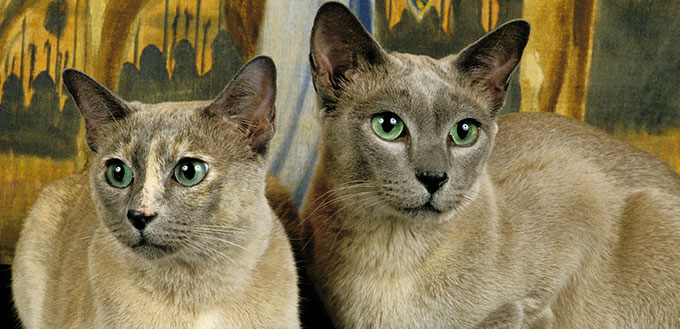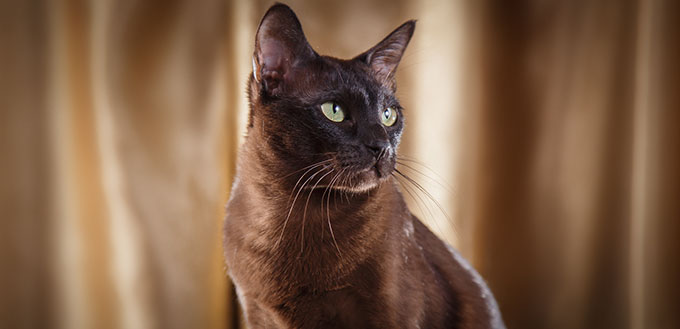Bold yet affectionate, a Tonkinese cat is the perfect addition to your family. Recognizable due to their wistful, almond shaped eyes, the breed’s wonderful temperament and sociable nature has led to them becoming among the most popular breeds in America. Tonkinese cats are known around the world for their beauty; your typical Tonkinese is a brown cat, with darker brown points around their fur and piercing aquamarine-colored eyes that are famous for melting cat enthusiasts’ hearts. If you’re interested in welcoming a Tonk into your life or simply want to know more about the breed of your feline companion, read on to discover their diverse origins, misconceptions concerning the breed, and how to best attend to their needs.
History of the Tonkinese Cat
In order to fully comprehend the rich history of the noble Tonkinese Cat, you must first be told the story of Wong Mau; a cat who found fame thanks to her walnut colored coat. Initially, it was thought that the Tonkinese breed came to exist as a result of breeding programs combining the Burmese and Siamese breeds together in the 1960s. Two independent breeding programs were put in motion: one Canadian-based program led by Margaret Conroy and the other based in New Jersey driven forward by Jane Barletta. The breeding programs produced beautiful litters of dark brown cats with seal brown markings on their ears, legs, tails, and face.
If this were the end of the origins of the breed, their history would be pretty self-explanatory. Yet the story continues. Arriving by sea as a gift to Dr. Joseph Thompson by a sailor in the 1930s who knew of his great interest in cats, the doctor immediately took an interest in Wong Mau’s walnut colored coat and darker points on her face. Accordingly, Dr Thompson conducted a genetic analysis of Wong Mau’s coat with the help of other esteemed scientists. The results of the analysis confirmed that Wong Mau was, in fact, a Burmese-Siamese hybrid – in other words, a naturally-occurring Tonkinese. Another notable event in history pointing to the natural breeding of Tonkinese cats was in 1880, as the breed were first recorded as “a chocolate variety of the royal Siamese cat”. Therefore, the claim that the Tonkinese is the result of Siamese and Burmese breeding isn’t so clear-cut.
In recent decades, the breed has been officially acknowledged by major pedigree organizations including the Independent Cat Federation, the Tonkinese Breed Club, and the Cat Fanciers Federation. Nowadays, the Tonkinese cat is rightly being recognized by all influential organizations for the wonderful cats they are.
Quick Facts About the Tonkinese Cat
Although widely rumored to be, Tonkinese Cats aren’t non-allergenic: Although many allergy sufferers do remark that felines of this breed are easy to tolerate due to their short hair and low shedding, this doesn’t stop Tonkinese cats’ production of the ‘Fel d 1’ protein. Responsible for the vast majority of cat allergens, the ‘Fel d 1′ protein is produced in cats’ saliva and resides on cat hair and skin when they groom themselves. Once an allergy sufferer pets the cat after grooming, it’s game over. Terrifyingly enough, ‘Fel d 1’ protein particles are so minuscule that they are able to hang suspended in the air, waiting to be inhaled by poor allergy sufferers. Due to the disturbing buoyancy of these protein particles, non-allergenic cats are simply a myth. Yet Tonkinese cats may be partly regarded as a hypoallergenic breed. As they groom themselves substantially less when compared to long-haired breeds, a Tonkinese produces substantially less ‘dander’ than long-haired cats, alleviating allergy sufferers from their symptoms.
They’re expensive cats: You can purchase a Tonkinese cat for between $600 to $1000 dollars. Their price depends on their pedigree and color. The steep price to purchase a Tonkinese is largely due to their beauty but also as a result of their wonderful temperament and colorful personalities.
Tonkinese point colors darken as they age: The coat is any young Tonkinese is of great fascination to breeders, as how their coat will develop is often a mystery. The color contrast between a young Tonkinese’s points and body is produced by enzyme and pigment interactions affected by body temperature. In fact, there are twelve different coat patterns. As your young Tonkinese darkens with age, it will become clearer what coat pattern type they fit into.
Things You Should Know
Health
Selective breeding has largely contributed towards Tonkinese cats living an average of twelve to sixteen years. However, as with all cat breeds, Tonkinese cats are more prone to develop certain health conditions than others, detailed below:
Feline Lower Urinary Tract Disease (FLUTD): The Tonkinese breed, in conjunction with their Siamese and Burmese brothers and sisters, are prone to suffer from FLUTD – an all-encompassing term referring to a range of health conditions in a feline’s urinary tract. Some of these health conditions include stones or crystals that form in their urine. If you notice your Tonk squatting for prolonged periods of time, struggling to urinate, or crying out in pain, take them to a vet so they can receive the right treatment.
Inflammatory Bowel Disease (IBD): As humans who suffer from this debilitating disease will know, IBD is hard for Tonkinese cats to manage without the right medical treatment. Excessive cramping and muscle spasms are only some of the unpleasant symptoms. Thankfully, as Tonkinese cats aren’t afraid to vocally express themselves, there will be a noticeable difference in their volume levels if suffering from IBD. Other signs that your Tonk may be suffering from IBD is if they sit hunched up and constantly lick the fur on their belly in an attempt to relieve the pain. If your pet is suffering from inflammatory bowel disease, check out some of the best cat foods for ibd to help reduce inflammation.
Gingivitis: Like Siamese cats, Tonkinese cats are prone to Gingivitis – the inflammation of gum tissue as a result of films of plaque or bacteria. If left untreated, the condition can lead to the tissue and bone around the gums becoming affected, later resulting in loss of teeth.
Feeding
As Tonkinese cats are wonderfully vocal, they won’t be shy when letting you know that it’s dinnertime. Cats’ digestive systems thrive when fed several small meals throughout the day (approximately two or three meals). Spreading their meals out in the day won’t only be better for your Tonkinese’s digestion: hopefully, they’ll stop whining about how hungry they’ve become too! All cats possess the metabolic rate and body composition of carnivores, so their diet should be high in probiotics, prebiotics, and animal-based protein sources. Regarding the latter, Tonkinese cats are rumored to go absolutely nuts for foods that contain either fresh chicken or fish. Thankfully, there are plenty of healthy varieties of kibble that cater to these cravings.
Care
Given that Tonkinese cats are susceptible to periodontal diseases like gingivitis, it is essential that owners brush their teeth one a week as a prevention method. Your Tonk may hate this grooming process initially; yet by using positive reinforcement as a tool over several sessions, they’ll begin to accept it. One incredibly helpful article created by the American Association of Feline Practitioners contains step-by-step instructions on how to make tooth brushing a positive experience for both you and your Tonkinese.
Related Posts: Cat Toothpaste and Cat Toothbrushes
Grooming
One of the major perks of owning a Tonkinese in comparison to other long-haired breeds is the lack of cleaning up hairs shed all over your home. Their short fur is easy to maintain, and the breed only require brushing every so often so their owner can check for lumps, fleas, and skin irritation.
Temperament
Your typical Tonkinese is the feline equivalent of your chatty friend who has opinions on everything. Whether your Tonk is feeling tired, anxious, or playful, don’t worry; they certainly won’t keep you in the dark! True Tonkinese lovers consider their Tonks ‘speaking’ as top of their favorite characteristics of their furry feline.
If you have children at home, your Tonk will absolutely adore them: an average cat of this breed will especially get along well with gentle children who have been taught not to push them out of their comfort zone. One reason we believe Tonkinese cats adore having children around the house is due to their potential to become lonely. In this regard, you should treat your Tonkinese as you would owning a dog: leaving them alone for long periods of time may drive cats of this breed to distraction. On a similar vein, if you are often out of the house working and tend not to spend much time in your home, choosing a breed that enjoys being more independent is recommended.
A Tonkinese cat’s love of company is why breed experts recommend owning two Tonks at once. As they’re a highly intelligent and sociable breed, Tonkinese kittens should preferably be bought in twos so they’ll keep each other entertained when you’re too busy to cater to their needs.
Overall, these wonderful cats are itching to be involved in family life and are a constant source of amusement and love. We couldn’t recommend them more!
Sources:
- Meredith Hooker Williams, 5 Reasons a Tonkinese Might Be the Right Cat Breed for You, Vetstreet
- Tonkinese, PetMD








